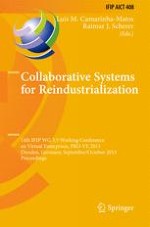This book constitutes the refereed proceedings of the 14th IFIP WG 5.5 Working Conference on Virtual Enterprises, PRO-VE 2013, held in Dresden, Germany, in September/October 2013. The 75 revised papers were carefully selected for inclusion in this volume. They provide a comprehensive overview of identified challenges and recent advances in various collaborative network (CN) domains and their applications with a particular focus on the support for reindustrialization. The papers have been organized in the following topical sections: product-service ecosystems; innovation in networks; strategies to build collaborative networks; collaboration related processes and performance; models and meta-models of collaboration; cloud-based support to collaborative networks; collaborative platforms; services and service design; sustainable collaborative networks; event-driven collaborative networks; social-semantic enterprise; and risks and trust.
